There’s an argument in the fitness world that you can either choose to lose fat OR gain muscle.
They just can’t be done simultaneously.
To this, Toronto personal Trainer says, “Hogwash!”
We have tons of success stories from our online coaching clients who have been able to do both simultaneously:
And that’s what we’ll cover in today’s guide!
We’ll do so by discussing:
- What is body recomposition?
- Losing fat and gaining muscle at the same time (The Controversy)
- How to lose fat.
- How to gain muscle.
- How to lose fat WHILE gaining muscle (The Science).
- Tips to lose body fat while gaining muscle.
- What should I eat to gain muscle and lose fat? (A Healthy Plate)
- How to tell if it’s all working (Continuing to lose fat while gaining muscle).
- Can I do body composition forever?
What’s Body Recomposition?
As Coach highlighted in the video above, achieving muscle gain and fat loss simultaneously is referred to as “body recomposition.”
So, the possibility of this process is indeed real, provided you adhere to an appropriate plan.
But you don’t have to simply take my word for it.
As I noted in the introduction, it’s a common belief that shedding fat while gaining muscle is an unattainable feat. The argument is often made that one should concentrate on either fat loss or muscle gain, as attempting both simultaneously is believed to be a doomed endeavor.
Let’s examine this assertion.
Losing Fat and Gaining Muscle at the Same Time (The Controversy)
To understand why losing fat while gaining muscle can be problematic, we need to explore both processes.
Let’s consider the following points:
- To lose fat, your body needs to be in a caloric deficit. This deficit forces your body to use pre-existing fat stores for fuel.
- To gain muscle, your body needs to be in a caloric surplus. This surplus provides the energy your body requires to repair and build bigger muscles.
Given this, losing fat (caloric deficit) at the same time one is gaining muscle (caloric surplus) seems impossible.
However, if we go a few steps deeper into the science, it IS possible!
To appreciate the nuance here, let’s get into some specifics on losing fat and gaining muscle separately, and then we’ll combine them.
HOW DO YOU LOSE FAT?
Losing body fat involves a simple and a slightly more complex approach.
The straightforward answer: “consume fewer calories than you burn or expend.” In essence, a caloric deficit.
When your body requires more calories than you provide through your diet, you enter a “caloric deficit.” Without enough fuel, your body starts utilizing its own components for energy.
To elaborate, when in a caloric deficit, your body taps into its fat reserves and existing muscle for fuel.
From a physique and health perspective, it’s essential to minimize muscle breakdown during a caloric deficit, prioritizing fat stores as the energy source.
This underscores an important point: the objective in fitness isn’t just “weight loss,” despite common terminology. The goal is to reduce body fat while preserving or even building muscle. This approach results in an improved physique and overall health.
This is why there’s significant interest in devices claiming to measure body fat percentage. By reducing overall body fat or increasing muscle mass, you lower your body fat percentage, a ratio of fat to total body composition.
Lower body fat percentages lead to the coveted “toned arms” and “6-pack abs.”
We will discuss tips on preserving and enhancing muscle during a caloric deficit later in this guide. For now, remember that for weight loss—whether from fat stores or muscle—you need to consume fewer calories than you burn.
You might wonder, ” What’s easier to do? Burn more calories or consume less?”
It’s a valid question, and let’s look at the numbers. While this is a simplified view, the ‘widely accepted’ notion is that “3,500 calories roughly equate to one pound of fat.”
If your goal is to lose one pound (approximately half a kilogram) of body fat in a week, a feasible and sustainable objective, you’d need a caloric deficit of 500 calories per day.
Your options to create this caloric deficit include:
- Consuming 500 fewer calories.
- Burning 500 more calories.
- A combination of both.
Which is easier?
Here’s the breakdown: 500 calories is equivalent to:
- The calories in a Big Gulp of Mountain Dew.
- An estimate of calories burned from running five miles.
When it comes to maintaining a caloric deficit, it’s primarily about your diet. Consuming 500 fewer calories is significantly more effective and efficient than burning an extra 500 calories.
As Time magazine provocatively stated, supported by numerous studies, “exercise alone won’t make you thin.” Adding calories through exercise is easy, and influencing “calories out” demands extensive effort.
This brings us to a slightly more intricate answer for achieving a fit body:
To reduce body fat, you need to monitor your diet in a sustainable manner.
At Toronto personal Trainer, we strongly believe that 80-90% of the fat-loss journey revolves around diet.
We emphasize the importance of focusing on EATING MOSTLY UNPROCESSED FOODS, including meat, fish, eggs, vegetables, fruits, and nuts.
These options are nutrient-dense, usually lower in calories compared to processed alternatives, and they help you feel satiated without overeating.
Consider the difference between 200 calories of broccoli versus 200 calories of a bagel.
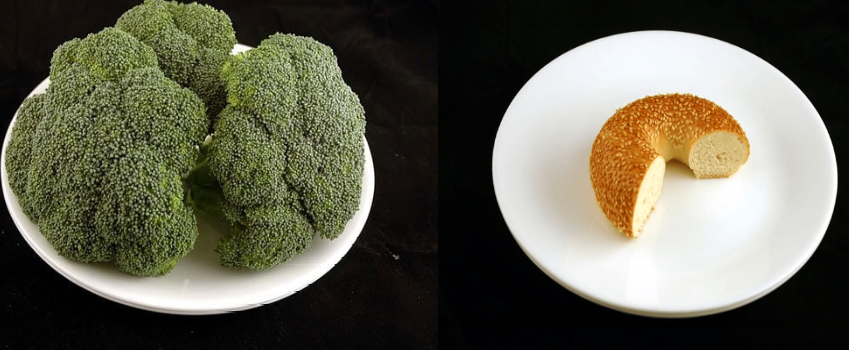
Opting for real, unprocessed food is the key to achieving a sustainable caloric deficit.
To guide you towards a “REAL food” eating pattern, we have an in-depth Beginner’s Guide to Healthy Eating. This resource provides insights into forming gradual habits that lead to a “REAL food” approach, encompassing appropriate portion sizes, batch cooking tips, and even a cameo from Winnie the Pooh.
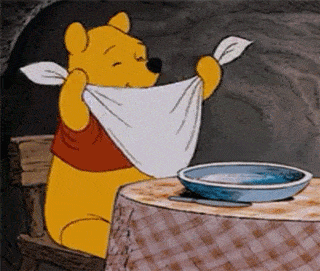
We encourage a gradual approach, allowing new habits of healthy eating to become permanent, something you can sustain throughout your life. This is a strategy we closely implement with our coaching clients: suggesting small nutritional changes they feel comfortable adopting. It’s how some of them have successfully shed 50-100 pounds!
To reiterate, 80%-90% of the fat loss equation pertains to what you eat. The remaining 10%-20% involves exercise.
Of course, exercise is a vital component, which leads us to the next segment.
HOW DO YOU GAIN MUSCLE?
If you want to build muscle, you’ll have to lift heavy things and ensure that your body has enough calories and protein to adapt by building more muscle.
In our Beginner’s Guide to Building Muscle and Strength, I summarize it as follows:
- Lift heavy things
- Eat a diet based on your goals
- Rest so your body can recover
Let’s chat about each one quickly.
1) LIFT HEAVY THINGS
I will always be on Team Strength Training. If you’re looking to build muscle, you’re gonna need to lift heavy things.
When you lift an object (or your own bodyweight) enough times, your muscles reach the point of failure. This causes your muscles to tear and breakdown.
When your muscle rebuilds itself following the workout, it’ll be bigger and stronger than before. Then you do it again.
And again.
And again.
As long as you are eating enough to rebuild your muscle, you’ll get stronger!
2) EAT A DIET BASED ON YOUR GOALS
Because your muscle needs to be rebuilt after exercise, the calories are gonna need to come from somewhere. I’ll talk a lot about proper diet in the next section (with a Harry Potter analogy), so I won’t spend too much time on it here.
Just know that eating the right quantity of foods will be a big part of gaining muscle.
3) REST
Your body rebuilds itself while you sleep, so make sure you get plenty of rest each night. I’m talking 7-8+ hours. This will help ensure your body has the time it needs to grow stronger.
If you’re strength training and only getting 6 hours of sleep a night or less, you’re really doing yourself a disservice. Go to bed!
That’s the short gist of how to build strength: challenge your muscles, eat well, and get some rest.
Let’s narrow in on our second point, “Eat a diet based on your goals.” It’ll become very important when balancing both losing body fat and gaining muscle.
How to Lose Fat WHILE Gaining Muscle (The Science)
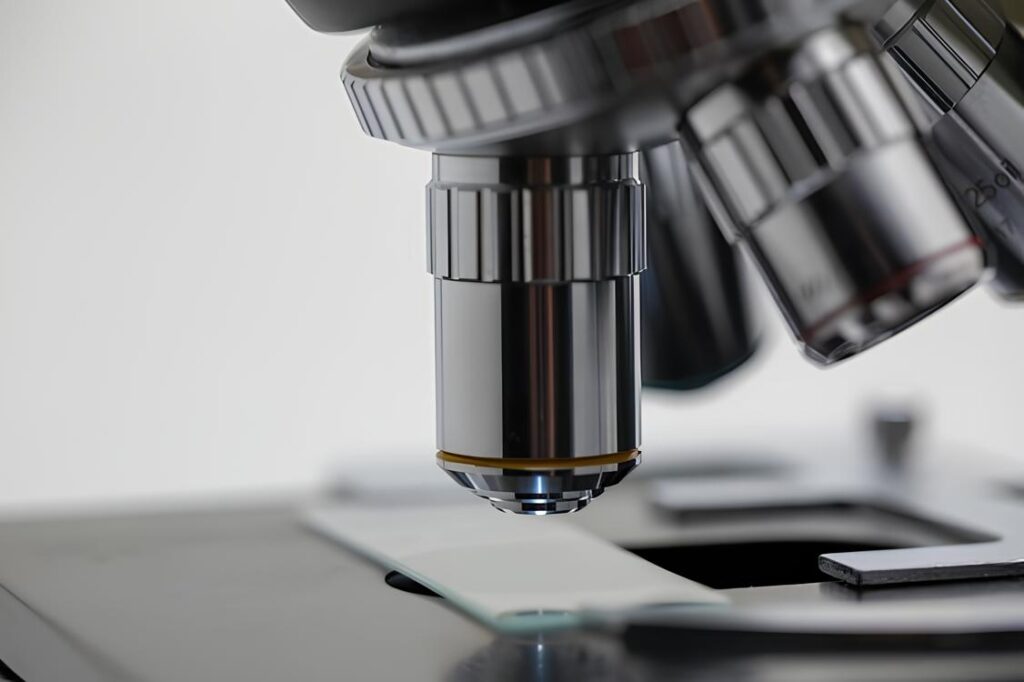
Let me illustrate the concept of losing body fat and gaining muscle simultaneously with a metaphor from the magical world of Harry Potter.
Imagine the “Sorting Hat” at Hogwarts, which was responsible for placing students into one of the four houses. It directed each student to the house where they belonged, like a traffic director guiding them: “Harry, you will go to Gryffindor! Draco, you will go to Slytherin!”
In a similar vein, your body functions as an efficient sorting hat when it comes to calories. Every day, as you consume food, your body needs to decide what to do with those calories.
To simplify this process, let’s categorize the calories into three metaphorical houses:
- A. Burn for Fuel
- B. Rebuild Muscle
- C. Store as Fat
When you eat, most of the calories are immediately sorted into the “Burn for Fuel” house. Your body requires a certain number of calories just to maintain essential functions—keeping your organs functioning, your heart beating, your brain working, and maintaining your body temperature. This is known as your “Basal Metabolic Rate” (BMR).
However, we encounter an issue when you consume excess calories that your body doesn’t need to fuel itself. In such cases, these surplus calories are sent to the “Store as Fat” house.
Our objective, however, is the opposite. We aim to maintain or build muscle while reducing body fat.
Now, consider a scenario where we combine heavy strength training with a reduction in caloric intake:
- Regular strength training causes your muscles to break down and require rebuilding.
- However, the calorie intake is insufficient to both rebuild the muscles and fuel the body, leaving no surplus for the “Burn for Fuel” and “Rebuild Muscle” houses.
Does this mean your body comes to a standstill? Not at all.
Your body has prepared for such circumstances by storing excess calories over the years in the “Store as Fat” house. Consequently, your body can utilize the stored fat to ensure all necessary functions are carried out, including daily activities and the rebuilding of torn muscles.
In other words:
If you have fat stores (and we all do), you don’t necessarily need a “caloric surplus” to rebuild muscle. The calories stored in your fat cells serve as the required energy source for this purpose.
Moreover, there is evidence suggesting that muscle can actually grow even while in a caloric deficit.
This translates to having more significant muscles with a smaller waistline.
TIPS TO LOSE BODY FAT WHILE GAINING MUSCLE
Let’s bring this all together and create some actionable steps to losing body fat and building muscle at the same time.
1) SUSTAIN A CALORIC DEFICIT WHILE EATING ENOUGH PROTEIN
You need your body to burn more calories than you consume, and also provide your body with enough protein to rebuild its muscle.
You can only lose fat if you’re in a calorie deficit.
Remember the Sorting Hat analogy:
If you’re eating too much, your excess calories are being sent to the “Store as Fat” house.
We want to pull from this house instead. So eat less than you burn consistently.
Count calories: This means learning your total daily energy expenditure, and tracking your other calories through an app (and/or weighing your food).
You don’t have to follow some predetermined blueprint like “low-carb.” You can create your own diet (which is what I do).
2) STRENGTH TRAIN
If you could sell a pill that could be prescribed to every single person on Earth to make them healthier, it would look something like a strength training routine in a bottle.
It is one of the best things you can do for your body.
And really, if you want to build muscle, you’re gonna need to lift something! Either weights or your own bodyweight.
You need to challenge your muscles in order for them to get stronger. Now, as we discuss in our article on the correct number of reps and sets, there are multiple ways to do so.
To recap: if you train heavy and eat a caloric deficit, your body will pull from its fat stores to both fuel itself and potentially also build muscle. This is a double whammy of AWESOME.
3) PRIORITIZE PROTEIN
Outside of being in a caloric deficit and lifting weights (or yourself), eating enough protein is one of the key components of both losing body fat and building muscle.
Protein is the number one nutrient for creating new tissue.
So when you cut out calories to create a caloric deficit, don’t cut them from protein sources.
Studies have shown that participants can gain muscle, even while in a caloric deficit, as long as they eat enough protein.
How much protein?
As we point out in our Guide to Protein, roughly 1 gram for every pound of your weight, with an upper limit of 250 grams. Or two grams for every kilogram if you are on the metric system. This means:
- If you weigh 300 pounds (136 kg), eat 250g of protein.
- If you weigh 250 pounds (113 kg), eat 250g of protein.
- If you weigh 200 pounds (91 kg), eat 200g of protein.
- If you weigh 180 pounds (82 kg), eat 180g of protein.
The gist: don’t skip out on protein. It should be on your plate for every meal (we’ll show you exactly how much in the next section).
If these generalized recommendations stress you out, and you want to know exactly what to do, we can help!
WHAT SHOULD I EAT TO LOSE FAT AND GAIN MUSCLE?
Always keep in mind two key points for losing fat while gaining muscle through your eating plan:
- Maintain a caloric deficit.
- Prioritize protein to support muscle growth, even within a deficit.
Now, let’s visualize what this looks like in practice! Referencing The Nerd’s Guide to Healthy Eating, a balanced plate includes the following elements:
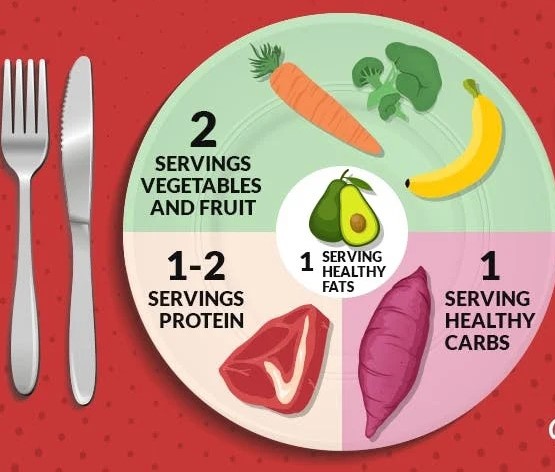
- 1-2 servings of protein (occupying ¼ of the plate)
- 2 servings of vegetables (filling half of the plate)
- 1 serving of potatoes, rice, or pasta (comprising 1/4th of the plate)
- 1 serving of healthy fat (equivalent to the size of your thumb)
- 1 zero-calorie or low-calorie beverage (such as water, diet soda, or tea)
By adhering to this Healthy Plate strategy, you’ll primarily focus on consuming “REAL food,” aiding you in sustaining a caloric deficit over time.
Now, let’s emphasize the importance of protein in this approach, as it plays a crucial role in muscle building.
Protein can be derived from various sources, including:
- Meat (such as steak, bison, pork)
- Poultry (including chicken, turkey, duck)
- Eggs!
- Fish and shellfish (like salmon, tuna, shrimp)
- Legumes (including black beans, chickpeas)
For those who prefer plant-based options, we’ve compiled an extensive guide to assist you!
A serving of protein should approximately be the size and thickness of your palm.
To provide an idea of protein content in different food servings:
- A 4 oz (113 g) serving of chicken contains roughly 30 g of protein.
- A 4 oz (113 g) serving of salmon provides around 23 g of protein.
- A 4 oz (113 g) serving of steak supplies approximately 28 g of protein.
While all components of the Healthy Plate are vital, pay extra attention to your protein intake, especially when aiming for muscle growth.
If you struggle to meet your protein goals, consider consulting our Protein Supplements Guide for helpful tips and delightful smoothie recipes to boost your intake.
This precise strategy was instrumental in my personal journey, helping me shed 22 pounds and achieve single-digit body fat percentages while simultaneously building muscle:
- Engage in heavy weightlifting.
- Consume ample protein.
- Reduce carbohydrate and fat consumption.
If weight loss is not occurring, it suggests an excess in calorie intake. Maintain a high protein intake while reducing fats and carbohydrates.
As you progress, you may reach a point where your body lacks adequate fat for muscle rebuilding. At this stage, transitioning to a slight “caloric surplus” is necessary to foster further muscle growth.
The precise timing of this transition varies from person to person. A good starting point is achieving 8% body fat for men and 16% body fat for women.
Explore this concept thoroughly in our guide, “How to Build Muscle.” If you’ve encountered challenges in gaining muscle, this guide can provide valuable insights.
It’s essential to emphasize that if you engage in heavy lifting without experiencing muscle gain, your diet is likely the underlying issue.
If you seek an expert’s guidance on optimal eating patterns, including when to adjust your calorie intake, explore our 1-on-1 Online Coaching Program for tailored assistance.
HOW TO TELL IF IT’S ALL WORKING (Continuing to Lose Fat While Gaining Muscle)
If you’re trying to improve something, it’s important to track it. This also holds true of body composition.
Most people do this by jumping on the scale. This can be “okay,” but it’s only going to tell part of the story.
If you’re building muscle while losing fat, the scale might not go down.
Despite weighing the same, you could potentially have an improved physique.
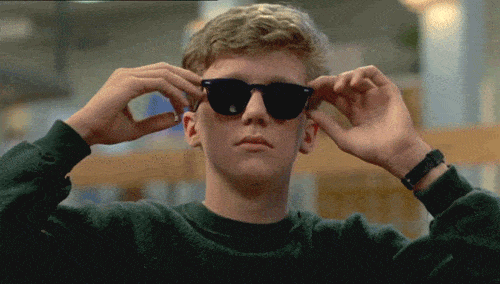
That’s why in addition to jumping on the scale, I would also encourage you to take progress photos.
Take front and side photos in your mirror, wearing underwear or a bathing suit. Each week, take new photos, and record the number on the scale under the same scenario. Two forms of tracking here allow us to get the full picture.
The scale sometimes lies!
If you eat for a caloric deficit, strength train, and prioritize protein, see what happens.
You may find yourself losing some fat and gaining muscle.
If not, track each category:
- Are you really in a caloric deficit? Track your calories to find out.
- Are you lifting enough? Perform resistance training consistently and track your workouts to determine whether or not you’re progressing via increased weight or repetitions.
- Are you prioritizing protein in your meals? Track your macronutrient breakdown each time you eat.
Oftentimes if you’re not seeing desired results, notes and record-keeping can help point us in the direction to make adjustments.
Test your assumptions if things don’t appear to be on track.
The tips outlined above will get you started losing fat while building muscle.
